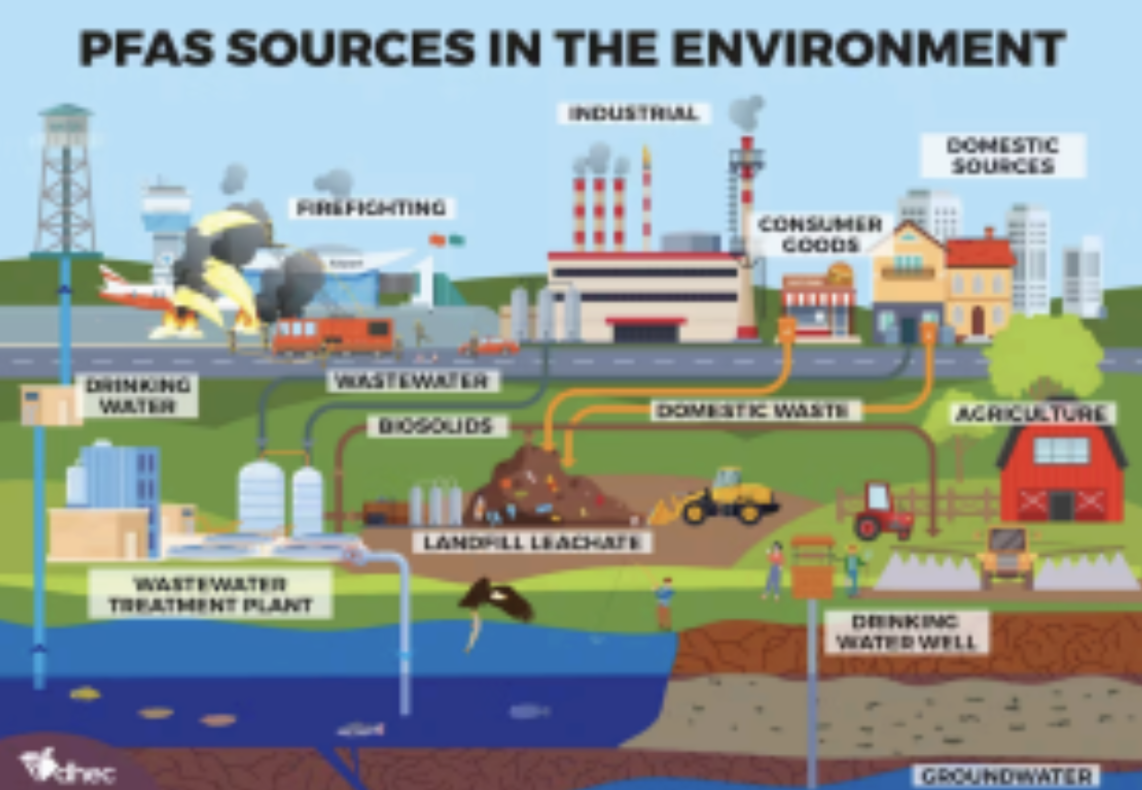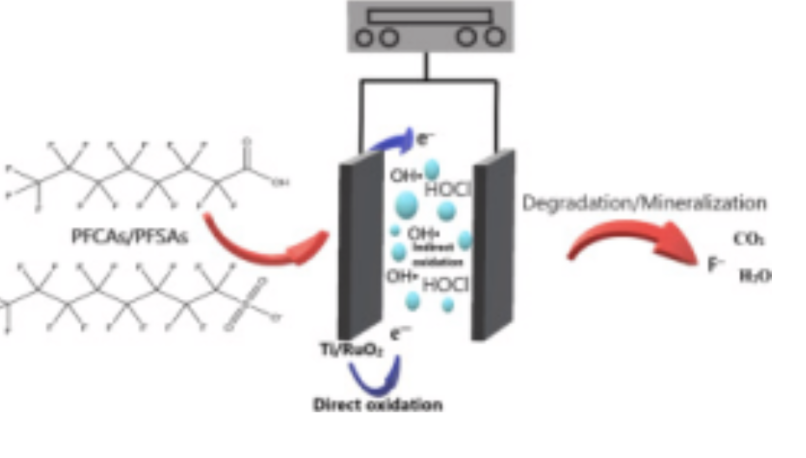Unraveling the tough bond of forever chemicals and their health implications
By: Sudipta Rudra
In today's world, there are nearly 85,000 man-made chemicals, yet only 1% are studied for safety (Endocrine Society, 2019). These synthetic substances, produced in laboratories, fulfill a myriad of essential functions to modern society. However, they do not come without their disadvantages. Forever chemicals, a class of man-made chemicals formerly known as per- and polyfluoroalkyl substances (PFAS), make products stain-resistant, water-resistant, and stick-proof (Ginty & Lindwall, 2024). Their chemical structure is highly stable and resistant to degradation, which is why they have been given the name “forever chemicals”; however, although useful, they have affected human health, damaged ecosystems, and contaminated the environment. Since the 1940s, forever chemicals have been produced and utilized by companies and industries to a large extent, infiltrating our food, air, and water. While there is growing awareness about their potential dangers, research continues to unveil their impacts on human health and the environment, as well as to explore possible solutions.
With advancements in science and technology, PFAS have countless applications spanning from the aerospace, automobile, electronics, military, and construction industries to everyday essentials like paints, cosmetics, firefighting foams, fast-food packaging, and pesticides (Sivagami et al., 2022). Their resistance to water and grease is both practical and convenient, making them invaluable to modern life.
The chemical structure of PFAs is characterized by a chain of linked carbon and fluorine atoms. The bond between a carbon and fluorine atom is covalent, meaning electrons are shared between the two atoms. Fluorine is the most electronegative element, creating partial charges as the electrons go toward fluorine, leaving carbon electron-poor. The carbon-fluorine (C-F) bond is one of the strongest in nature, and PFAS contain a series of such bonds. This intrinsic stability highlights their near indestructibility, resistant to breakdown even under extreme temperatures.
The resilience of PFAS makes their manufacturing controversial due to environmental impacts. As PFAS-containing products are used, they are washed down drains and thrown in landfills, causing PFAS to become widespread in the environment (Quinete & Ogunbiyi, 2023). PFAS have been found in the farthest corners of the planet – from polar bears in Alaska to pilot whales in the Faroe Islands of the North Atlantic (Beans, 2021) – and have reached the highest altitudes of the planet, with PFAS found in snow and meltwater on Mount Everest (Miner et al., 2021). A study by the U.S Geological Survey found that these chemicals were in at least 45% of tap water across the U.S (Quinete & Ogunbiyi, 2023), and one report by the Centers for Disease Control and Prevention found PFAS in the blood of 97% Americans (Beans, 2021).
Figure 2: A pronounced representation of how PFAS can easily contaminate our environment and adulterate our water.
Scientists are currently studying the risk that constant exposure of PFAS poses to public health. Recent studies have shown that PFAS are directly linked to negative impacts on the immune system, reducing the ability to fight disease or respond to a vaccine (Beans, 2021). Furthermore, Phillippe Grandjean, an adjunct professor of environmental health at Harvard University, tracked PFAS levels from the birth of nearly 600 children born between 1997-2000, along with the children's levels of antibodies against diphtheria and tetanus. His team found that a doubling of PFOS exposure at birth was associated with almost a 40% drop in diphtheria antibody concentration at age 5 (Beans, 2021). This exposure to PFOS and PFOA made children 2.4-4.2 times more likely to fall below the protective level for tetanus and diphtheria antibodies at age 7, indicating that PFAS can suppress the human immune response (Beans, 2021). Additionally, PFA exposure is linked to a multitude of adverse health consequences: reproductive and developmental effects, interference with the endocrine system, increased cholesterol levels, thyroid disease, liver damage, and kidney and testicular cancers (EPA, 2024). Overall, the sheer health effects of PFAS raise significant concerns about their prevalent usage.
With widespread contamination of PFAs in the environment and clear health risks posed by them, promising solutions are being developed to address this issue. Electrochemical-based approaches for treating PFAS have shown superior function regarding its energy efficiency and treatment (Sivagami et al., 2022). Specifically, electro-oxidation is an electrochemical process that involves a chemical reaction driven by an electric current. In this process, electricity drives a chemical reaction; electrodes (e.g. zinc, copper, lead) help create the reaction by transferring electrons. Electro-oxidation (EO) is a recent development that treats PFAS, where different reactive species are generated at the anode due to oxidation and reduction reactions at the cathode (Sivagami et al., 2022). EO almost completely mineralizes non-biodegradable organic matter and integrated approaches with electrodes such as zinc, titanium, and lead improved efficiency in treating PFAS with the range of 65 to 97% (Sivagami et al., 2022). With this method, the pollutants are degraded into simpler compounds as the electron transfer reactions cause them to go under oxidative degradation (Figure 3). Electrochemical systems are safe and cost-effective, complying with the strictest regulations.
Figure 3: The electro-oxidation process to turn PFAS into simpler compounds with titanium and Ruthenium (IV) oxide. (Barışçı, & Suri, 2021)
Novel solutions to treat PFAS continues to progress, as research centers develop energy-efficient nanoreactors to break the C-F bond, leverage land use data to identify the risk of PFAS exposure, and explore options for containment strategies with aqueous film-forming foams for firefighting, a significant source of PFAS (National Institute of Environmental Health Sciences, n.d.). Recently, the Biden-Harris Administration issued a drinking water standard to protect communities from PFAS, projected to reduce exposure for approximately 100 million people (EPA, 2024). In addition, PFAS exposure can be reduced with personal choices such as avoiding non-stick pans, researching PFAS testing in your area, and avoiding grease-resistant packaging (Ginty & Lindwall, 2024). With continuing legislation and research on PFAS, there is hope to minimize the harsh effect of PFAS on human health, while maintaining their convenient applications.
References
Barışçı, S., & Suri, R. (2021, March 9). Electrooxidation of short- and long-chain perfluoroalkyl substances (pfass) under different process conditions. Journal of Environmental Chemical Engineering. https://www.sciencedirect.com/science/article/abs/pii/S2213343721003006
Beans, C. (2021). How “forever chemicals” might impair the immune system. Proceedings of the National Academy of Sciences, 118(15), e2105018118.
https://www.pnas.org/doi/abs/10.1073/pnas.2105018118
Centers for Disease Control and Prevention. (2024, November 12). PFAS and Your Health. Centers for Disease Control and Prevention.
https://www.atsdr.cdc.gov/pfas/about/?CDC_AAref_Val=https%3A%2F%2Fwww.atsdr.cdc.gov %2Fpfas%2Fresources%2Fpfas-faqs.html
Endocrine Society. (2019, November 20). Common edcs and where they are found. Endocrine Society.
https://www.endocrine.org/topics/edc/what-edcs-are/common-edcs
Environmental Protection Agency. (2024, April 10). Biden-Harris Administration Finalizes First-Ever National Drinking Water Standard to Protect 100M People from PFAS Pollution. EPA.
https://www.epa.gov/newsreleases/biden-harris-administration-finalizes-first-ever-national-drinki ng-water-standard
Environmental Protection Agency. (2024, November 26). Our Current Understanding of the Human Health and Environmental Risks of PFAS. EPA.
https://www.epa.gov/pfas/our-current-understanding-human-health-and-environmental-risks-pfas #:~:text=Developmental%20effects%20or%20delays%20in,infections%2C%20including%20red uced%20vaccine%20response
Environmental Working Group. What are PFAS chemicals? Environmental Working Group https://www.ewg.org/what-are-pfas-chemicals
Jones, S. (2021, March 31). Forever Chemicals. YouTube.
https://www.youtube.com/watch?v=tqKEG5LxPiY
Lindwall, C., & Ginty, M. M. (2024, April 10). “Forever chemicals” called pfas show up in your food, clothes, and home. Be a Force for the Future.
https://www.nrdc.org/stories/forever-chemicals-called-pfas-show-your-food-clothes-and-home
Miner, K. R., Clifford, H., Taruscio, T., Potocki, M., Solomon, G., Ritari, M., ... & Mayewski, P. A. (2021). Deposition of PFAS ‘forever chemicals’ on Mt. Everest. Science of the Total Environment, 759, 144421.
https://www.sciencedirect.com/science/article/abs/pii/S0048969720379523 Sivagami, K., Sharma, P., Karim, A. V., Mohanakrishna, G., Karthika, S., Divyapriya, G., ... & Kumar, A. N. (2023). Electrochemical-based approaches for the treatment of forever chemicals: removal of perfluoroalkyl and polyfluoroalkyl substances (PFAS) from wastewater. Science of the Total Environment, 861, 160440.
https://www.sciencedirect.com/science/article/abs/pii/S0048969722075428
U.S. Department of Health and Human Services. (n.d.). Perfluoroalkyl and Polyfluoroalkyl Substances (PFAS). National Institute of Environmental Health Sciences.
https://www.niehs.nih.gov/health/topics/agents/pfc
Image References
Barışçı, S., & Suri, R. (2021, March 9). Electrooxidation of short- and long-chain perfluoroalkyl substances (pfass) under different process conditions. Journal of Environmental Chemical Engineering. https://www.sciencedirect.com/science/article/abs/pii/S2213343721003006
Story Map Series. (2024). Arcgis.com
https://gaepd.maps.arcgis.com/apps/MapSeries/index.html?appid=e8f2c6a51c1c41088002350f1e abe598
Writer, C. (n.d.). How PFAS “forever chemicals” are getting into Miami’s Biscayne Bay, where dolphins, fish, and manatees dine. FIU News.
https://news.fiu.edu/2023/how-pfas-forever-chemicals-are-getting-into-miamis-biscayne-bay-wh ere-dolphins-fish-and-manatees-dine


